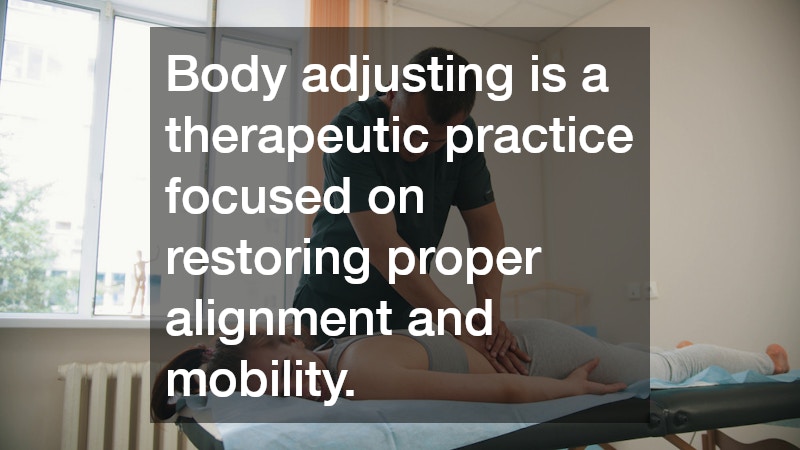Welcome to our comprehensive guide on body adjusting, a practice that has gained significant attention for its potential to relieve pain and enhance overall health. Many people wonder what body adjusting involves, how it differs from other therapies, and whether it could benefit them. This article will answer these questions, drawing on insights from professionals in chiropractic care, interventional pain jobs, and related health fields.
Body adjusting is more than a procedure; it is a holistic approach that considers the interconnectedness of muscles, joints, and the nervous system. By targeting specific areas of misalignment or tension, body adjusting can not only alleviate chronic pain but also promote improved posture, flexibility, and wellness. Whether you are exploring alternatives to medication, seeking adjunct therapies for conditions like ADHD treatment, or just curious about non-invasive wellness solutions, understanding body adjusting can empower you to make informed decisions about your health.

In this guide, we’ll discuss what body adjusting is, the mechanisms through which it aids pain relief, and the broader benefits it can have for overall health. We’ll also cover what to expect during a session, potential risks, and how to choose a qualified practitioner. Along the way, we’ll reference complementary services, including in-home care services, eye care exams, and family therapist consultations, to show how body adjusting fits within a holistic health framework.
What is Body Adjusting?
Definition and Principles
Body adjusting is a therapeutic practice focused on restoring proper alignment and mobility to the body’s musculoskeletal system. Traditionally associated with chiropractic adjustment, the practice has evolved to encompass a variety of techniques that aim to relieve discomfort, enhance physical function, and promote wellness. Modern body adjusting integrates methods from osteopathy, physical therapy, and other manual therapies, allowing practitioners to tailor treatments to the unique needs of each patient.

The core principle of body adjusting is that proper alignment of the spine and joints supports optimal nervous system function. Misalignments, also called subluxations, can lead to pain, reduced mobility, and even systemic health issues. By correcting these misalignments, body adjusting helps the body operate efficiently, reduces stress on muscles and joints, and enhances overall vitality. Beyond immediate pain relief, consistent adjustments may prevent chronic conditions, improve posture, and support balance and coordination.
Many patients also experience secondary benefits, such as improved circulation, enhanced sleep quality, and greater energy levels. In combination with routine healthcare practices—including regular visits to dentists, in-home care services, eye care exams, and consultation with a local chiropractor or health solutions partner—body adjusting contributes to a holistic approach to health. By addressing both structural and functional imbalances, it empowers individuals to maintain long-term wellness and actively participate in their overall health journey.
Different Techniques
There are several methods used in body adjusting, depending on the practitioner and the patient’s specific needs, overall health, and treatment goals. Understanding these techniques helps patients make informed choices and set realistic expectations for their care.
Chiropractic Adjustment remains one of the most recognized forms of body adjusting. It involves hands-on spinal manipulation to restore proper alignment, improve joint mobility, and reduce nerve interference. These adjustments can alleviate common complaints such as back pain, neck stiffness, headaches, and joint discomfort. Chiropractors may also provide guidance on posture, ergonomics, and targeted exercises to sustain the benefits of treatment over time.
Osteopathic Manipulations take a broader approach, focusing on the musculoskeletal system as a whole while also considering circulation, nerve function, and overall wellness. Techniques may include stretching, gentle pressure, and joint mobilization. Osteopaths often integrate lifestyle advice, nutrition guidance, and rehabilitative exercises to complement manual therapies, promoting not only pain relief but enhanced systemic function.
Soft Tissue Techniques for Muscle Relaxation and Pain Relief
Soft Tissue Techniques are used to relax muscles, improve circulation, and prepare the body for more structured adjustments. Methods such as massage therapy, myofascial release, and trigger point therapy target tight or overworked muscles, reduce inflammation, and relieve tension. These techniques can be especially helpful for patients dealing with chronic pain, postural strain, or recovery from injuries.
Practitioners often combine multiple methods to create a customized treatment plan tailored to the patient’s needs. For example, a patient may receive a chiropractic adjustment to correct spinal alignment, followed by soft tissue therapy to ease surrounding muscle tension. Complementary guidance on exercise, posture correction, and lifestyle adjustments further enhances the effectiveness of treatment.
Modern body adjusting also incorporates insights from other healthcare fields. Collaboration with caregivers, home care providers, or interventional pain jobs specialists can address more complex conditions, ensuring a holistic approach to pain management and wellness. By blending techniques and professional expertise, body adjusting delivers not only symptom relief but also long-term improvements in mobility, posture, and overall health.
Professional Practitioners
Qualified professionals who perform body adjusting include chiropractors, osteopaths, and physical therapists trained in manual therapy. These practitioners undergo extensive education and hands-on training to understand the musculoskeletal system, nervous system, and how misalignments affect overall health. Their expertise allows them to design individualized treatment plans, taking into account a patient’s medical history, lifestyle, and specific pain or mobility concerns.
When selecting a practitioner, it’s essential to look for credentials, experience, and patient reviews. Board certifications, state licensure, and professional affiliations signal a commitment to maintaining high standards of care. Many patients also consider the practitioner’s specialization, as some focus on sports injuries, chronic pain, or post-surgical rehabilitation, while others may emphasize preventive care and wellness.
In addition, collaboration between different healthcare providers can enhance outcomes. For instance, a local chiropractor performing body adjusting may work alongside interventional pain jobs specialists to address chronic or complex pain conditions. Similarly, coordination with in home care services ensures that patients who require additional support at home can safely continue their treatment plan. Family therapist services may also be involved when body adjusting is part of a holistic approach that considers mental and emotional well-being alongside physical health.
Practical considerations such as office accessibility, scheduling flexibility, and insurance coverage are equally important when choosing a practitioner. Patient comfort and clear communication are crucial for effective treatment, especially for first-time clients or those transitioning from other therapies. By carefully selecting a knowledgeable and well-connected professional, patients can experience the full benefits of body adjusting, ranging from pain relief and improved mobility to enhanced overall health and quality of life.
How Does Body Adjusting Help with Pain Relief?
Mechanisms of Pain Relief
Body adjusting alleviates pain by addressing the root causes of musculoskeletal imbalances. Misalignments in the spine or joints—commonly referred to as subluxations—can place undue pressure on nerves, muscles, and connective tissues. This pressure often leads to inflammation, restricted mobility, and persistent discomfort. By correcting these misalignments through precise adjustments, body adjusting restores proper alignment, reduces nerve interference, and allows muscles and joints to function more efficiently.
When joints are properly aligned, circulation improves, delivering oxygen and nutrients to tissues that may have been under stress or inflamed. This enhanced blood flow accelerates the healing process and helps the body naturally recover from injuries or chronic strain. In addition, body adjusting can stimulate the nervous system, improving communication between the brain and muscles, which supports better coordination, balance, and posture.
Adjustments also work in tandem with other therapies, such as chiropractic adjustment, soft tissue techniques, and osteopathic manipulations, to provide comprehensive relief. For patients experiencing chronic pain, integrating body adjusting with services like interventional pain jobs, in home care services, or consultations with a family therapist can further support recovery and overall well-being.
Scientific studies have shown that regular body adjusting can reduce reliance on pain medications and limit the risk of secondary complications caused by prolonged immobility or poor posture. Patients report relief from common conditions such as back pain, neck pain, headaches, joint discomfort, and repetitive strain injuries. By addressing both the symptoms and the underlying causes of pain, body adjusting offers a sustainable, non-invasive solution.
Ultimately, body adjusting provides more than temporary relief—it restores functional balance to the body, enhances mobility, and supports long-term health. Patients benefit not only from decreased pain but also from improved energy levels, better sleep, and enhanced overall quality of life.
Types of Pain Addressed
Body adjusting is effective for a range of conditions, including:
-
Back Pain: Chronic or acute lower back pain responds well to spinal adjustments.
-
Neck Pain: Correcting cervical alignment can reduce tension headaches and stiffness.
-
Joint Discomfort: Knees, shoulders, and wrists benefit from improved joint mechanics.
-
Headaches: Tension-type headaches or migraines can decrease with proper spinal alignment.
Case Studies and Patient Testimonials
Patients report noticeable improvements in pain levels, mobility, and quality of life after a series of adjustments. For instance, one patient with chronic back pain found relief after working with a chiropractor who incorporated body adjusting into their therapy plan alongside traditional interventional pain jobs. Others have experienced reduced dependency on medication and improved functional performance in daily tasks.
Can Body Adjusting Improve Overall Health?
Holistic Health Benefits
Body adjusting is not limited to pain relief—it can enhance overall health. Proper spinal alignment improves circulation, supports nerve function, and may contribute to better digestion, immune function, and mental clarity. Combining adjustments with services such as eye care exams, ADHD treatment, and family therapist support can create a comprehensive wellness plan.
Enhanced Body Functionality
Consistent body adjusting helps maintain proper posture, increases flexibility, and reduces the risk of injury. These improvements allow patients to engage in regular exercise, childcare responsibilities, and even demanding work routines without discomfort. Home care services often report that patients who maintain regular adjustments have better mobility and independence.
Prevention and Maintenance
Body adjusting serves as a preventative measure by addressing small misalignments before they develop into serious conditions. Regular adjustments, in conjunction with routine check-ins from caregivers or health solutions partners, can help sustain long-term musculoskeletal health.
What Should You Expect During a Body Adjusting Session?
Initial Consultation and Assessment
During your first visit, the practitioner will review your medical history, perform physical assessments, and may use imaging tools to identify misalignments. This thorough evaluation ensures that your session addresses your unique needs and complements other treatments such as chiropractic adjustment or interventional pain jobs.
The Adjustment Procedure
Adjustments involve precise, controlled movements to realign the spine or other joints. Some sessions also incorporate soft tissue techniques, stretching, or exercises. The process is generally painless, with many patients feeling immediate relief and improved mobility.

Post-Session Care and Advice
After an adjustment, practitioners often recommend hydration, gentle stretching, and maintaining proper posture. Patients may be advised to schedule follow-ups with their local chiropractor or coordinate with other providers, including home care or biohazard cleanup professionals if environmental health concerns exist.
Are There Any Risks or Considerations with Body Adjusting?
Potential Risks and Side Effects
While body adjusting is generally safe, some patients may experience temporary soreness, stiffness, or mild headaches. Severe complications are rare, especially when care is provided by licensed professionals.
Contraindications and Precautions
Patients with severe osteoporosis, fractures, or certain neurological conditions should consult their physician before receiving adjustments. Children, especially those in preschool or early childcare services, should only receive treatments tailored to their developmental stage.
Safety Measures and Regulations
Licensed practitioners adhere to safety protocols and industry regulations to minimize risk. Certifications and continuing education ensure that chiropractors and other body adjusting professionals provide safe and effective care.
Body adjusting offers significant benefits for pain relief and overall health. By collaborating with skilled dentists, a local chiropractor, or a qualified local orthodontist, and consulting with a health solutions partner, patients receive care that addresses both physical discomfort and overall wellness. This collaborative approach ensures that adjustments are tailored to individual needs, creating a personalized treatment plan that maximizes effectiveness while minimizing risks.
Regular adjustments can reduce reliance on medications, improve posture, and prevent future musculoskeletal issues. They support proper alignment, enhance flexibility, and increase the range of motion, making daily activities easier and less prone to strain or injury. The flexibility and holistic approach of body adjusting complement busy lifestyles, integrating seamlessly with services like in-home care services, ADHD treatment, childcare services, and even biohazard cleanup in medical or home environments, ensuring that patients can maintain a balanced, healthy life while addressing their pain management needs.
Moreover, body adjusting promotes preventive care. By identifying and addressing misalignments before they become significant problems, it reduces the likelihood of chronic conditions developing over time. This proactive approach not only saves time and healthcare costs but also contributes to improved long-term health outcomes. When combined with guidance from caregivers, regular eye care exams, and complementary therapies like chiropractic adjustment, patients experience a comprehensive wellness plan that encompasses both physical and mental health.
By embracing body adjusting as part of a holistic healthcare routine, individuals can achieve greater mobility, reduced pain, and enhanced overall well-being. Whether managing chronic back pain, joint discomfort, or simply striving for optimal health, body adjusting provides a safe, effective, and forward-thinking approach to improving quality of life and sustaining long-term wellness.




